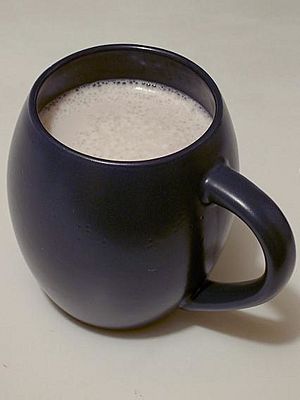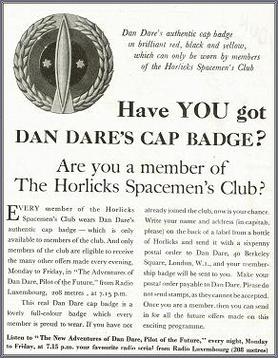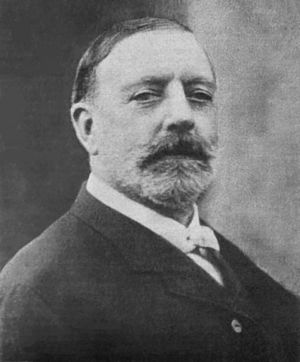Horlicks facts for kids
Horlicks is a sweet, warm drink powder. It's made from malted milk. Two brothers, James and William Horlick, created it.
When it first came out, it was called "Horlick's Infant and Invalids Food." This meant it was for babies and sick people. Later, they added "aged and travellers" to the label. In the early 1900s, it was sold as a powder to replace meals.
Over time, Horlicks became known as a healthy supplement. It was made by a company called GlaxoSmithKline in many countries. These included the UK, Malaysia, India, and others. Later, the big company Unilever started making it.
In 2018, Unilever bought the Horlicks business in India. This was a very big deal! The Horlicks business in the UK was sold to another company, Aimia Foods, in 2017.
In Britain, many people drink Horlicks before bed. But in India, it's often marketed as a breakfast drink.
Contents
What's in Horlicks?
The main things in Horlicks in the UK are wheat flour and malted wheat. These make up almost half of the drink. Malted barley is also a key ingredient.
Other ingredients include dried whey and skimmed milk. There's also sugar, palm oil, and salt. It has vitamins and minerals too, which are good for you! The palm oil used is from sustainable sources.
The recipe can be a bit different in various countries. For example, the Horlicks made in India doesn't have palm oil. But it does have soy protein.
Horlicks and Advertising
Horlicks has been advertised in many ways over the years.
- In 1952, Horlicks sponsored a radio show called Dan Dare, Pilot of the Future. It was a popular adventure series.
- In 1961, there was a TV ad with a Scottish entertainer, Billy Raymond. The ad's message was "Horlicks – the food drink of the night."
- Horlicks also sponsored Lum and Abner, another radio show, from 1934 to 1937.
Horlicks Around the World
Horlicks in India
Horlicks first came to India with the British Army. After World War I, Indian soldiers brought it home. It became a popular health drink for families. In the 1940s and 1950s, drinking Horlicks was a sign of being well-off.
India is now the biggest market for Horlicks. It's often called The Great Family Nourisher there. The Indian Horlicks is made from buffalo milk, not cow's milk.
In 2003, Horlicks added new flavors in India. These included vanilla, chocolate, and cardamom. Today, you can find original malt, chocolate, and cardamom flavors. There's even a new Kesar Badaam flavor.
Horlicks in India has grown a lot. It's not just a drink anymore! It's an umbrella brand for many products. These include instant noodles, candy, and breakfast cereal.
There are special Horlicks drinks for different people:
- Junior Horlicks for young children.
- Mother's Horlicks for new mothers.
- Women's Horlicks for women.
- Lite Horlicks for adults.
Horlicks also makes biscuits and energy bars. In 2009, they launched Foodles, which are instant noodles. In 2011, they introduced Horlicks Gold, a fancy version of the drink. They also launched Horlicks Oats for breakfast.
Horlicks is very popular in India. It's the most widely consumed packaged drink after bottled water.
Horlicks also runs events like Horlicks Wizkids. This is a big competition for children. It started in 2003 and has reached millions of kids. It takes place in India, Sri Lanka, Nepal, and Bangladesh. Kids can show their talents in arts, writing, and other activities.
Another project is Ahaar Abhiyan. This helps teach mothers and families about good nutrition. For every bottle of Horlicks sold, the company gives money to this cause.
Horlicks in Hong Kong
In Hong Kong, Horlicks is often a café drink. It's served in local tea houses called cha chaan tengs. You can also find it in fast-food places. It can be served hot or cold. People usually add sugar to make it sweet.
Horlicks in Southeast Asia
In countries like the Philippines and Malaysia, Horlicks was sold as candy discs. These were milky-chocolate flavored and came in paper packets. People would eat them like sweets.
Horlicks is still popular in Malaysia and Singapore. It's sold in big containers there. Its slogan is "Taller, stronger, sharper."
Horlicks in South Africa
In South Africa, Horlicks is used in milkshakes. A popular one is "honey and Horlicks" milkshake.
Horlicks in the United Kingdom
In the UK, Aimia Foods makes Horlicks. You can buy it in different types:
- Traditional (made with hot milk)
- Light (made with hot water)
- Light Chocolate (made with hot water)
In 2004, GlaxoSmithKline tried to update Horlicks for younger people. They changed the packaging and promoted it in trendy places.
Horlicks Company History

Here's a timeline of important events for Horlicks:
- 1869: William Horlick moved from England to the United States.
- 1873: William's brother, James, joined him. They started their company, J & W Horlicks, in Chicago. They made a special malted milk drink for babies.
- 1875: The business moved to a bigger place in Wisconsin.
- 1883: William got a patent for the first malted milk drink powder. You could mix it with hot water.
- 1890: James went back to London. He set up an office to sell the US-made Horlicks there.
- 1906: A new factory was planned in Slough, England.
- 1908: The factory was finished. It cost £28,000 to build.
- 1909–1910: Horlicks became popular for explorers! People like Robert Peary and Roald Amundsen took it on their trips to the North and South Poles.
- 1914: James Horlick was made a baronet (a special title). During World War I, many people drank Horlicks at home and on the front lines.
- 1921: James died. The company split. William took care of the Americas. James's sons managed the rest of the world.
- 1928: William Horlick High School was founded near the Horlicks office in Wisconsin.
- 1931: The "Night Starvation" idea was created. This helped promote Horlicks as a bedtime drink.
- 1935: Explorer Richard E. Byrd named the Horlick Mountains after William. This was to thank him for his support. A small factory opened in Australia. Horlicks also sold milky-chocolate candy discs in the USA. These were popular with kids.
- 1936: William Horlick passed away at 90 years old.
- 1945: The US Horlicks company was bought by the UK Horlicks business.
- 1952: Horlicks was found to help with stomach ulcers and some types of diabetes.
- 1960: A factory was built in Punjab, India. It made Horlicks from buffalo milk.
- 1969: The Beecham Group bought Horlicks.
- 1989: Beecham Group became SmithKline Beecham.
- 2000: SmithKline Beecham became GlaxoSmithKline.
- 2017: Aimia Foods bought Horlicks in the UK.
- 2019: Unilever bought Horlicks in India.





